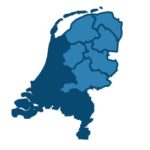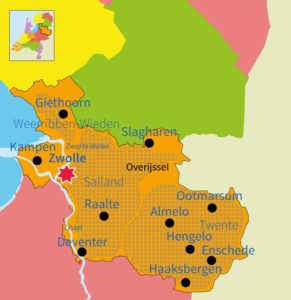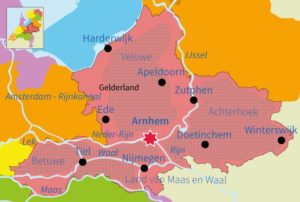Extinct – Netherlands North East
Introduction
 In the north-eastern part of the Netherlands with the provinces of Groningen, Friesland, Drenthe, Overijssel (adjacent county of Bentheim in Germany) and Gelderland, it seems that most of the data found are related anyway. In addition to the surviving family trees of Neuenhaus, Zwartsluis and Steenwijk, most other data also seem to be related to this. Many and diverse reports and references have been found in all possible archives of people with the name Van Dorsten (or name variants). And in addition to being used as a family name, the Hanseatic town of Dorsten was also regularly the place of origin of people. Because provinces (region) used to be much more important, a description is given below per province.
In the north-eastern part of the Netherlands with the provinces of Groningen, Friesland, Drenthe, Overijssel (adjacent county of Bentheim in Germany) and Gelderland, it seems that most of the data found are related anyway. In addition to the surviving family trees of Neuenhaus, Zwartsluis and Steenwijk, most other data also seem to be related to this. Many and diverse reports and references have been found in all possible archives of people with the name Van Dorsten (or name variants). And in addition to being used as a family name, the Hanseatic town of Dorsten was also regularly the place of origin of people. Because provinces (region) used to be much more important, a description is given below per province.
Friesland, Groningen and Drenthe
Few reports and references have been made in Groningen and Drenthe. Friesland did have the necessary small branches and unloading mentions, but this mainly concerned the period around 1700, and especially soldiers with their families.
Overijssel
The province of Overijssel is a region with many mentions and references from very early days. In addition to the trees of Zwartsluis and Steenwijk that originated here around 1700 (and probably derived from Neuenhaus), there are also many other (and older) references here. There is also a reasonable chance that it is related to Neuenhaus. What is striking is that many family trees in this region in the 18th century flared up to Amsterdam. Before 1550, there are mainly reports from the Hanseatic cities (partly because they already had more administration) and a number of separate reports here and there. A number of locations and tribes are worth noting:
- Zwolle (Hanseatic city) – In Zwolle there are various mentions in the archives from the beginning of the 15th century (until well into the 16th century), which indicates that a branch probably already existed at that time, but the mutual relationships are still not or difficult to determine. From the middle of the 16th century onwards it mainly concerned one of the well-known family trees.
- Kampen (Hanseatic city) – In Kampen there have been many reports from the late 15th century to the early 18th century. It seems that a wealthy family lived here (especially in the beginning) who in the 16th century still had clear relationships with Münsterland and the surrounding area of Dorsten. And although many archives are already available as transcripts, the mutual relationships are still largely unclear. However, much can still be obtained from the DTB data from before 1800. From one of the branches a well-known branch towards Amsterdam has emerged. There was also a piece of land called “Van Dorsten Slag” for a few hundred years, presumably owned by the wealthy family in the 16th / 17th century.
- Wanneperveen – A small branch existed in Wanneperveen for some time in the 18th century, probably related to Zwartsluis and / or Steenwijk. This later fanned out to Amsterdam and ceased to exist there.
- Raalte – A branch was also created in Raalte at the end of the 17th century, which may have been related to Zwartsluis and / or Steenwijk. It also fanned out to Amsterdam and became extinct there during the 18th century.
- In addition to the aforementioned, there are also several reports in Deventer (long ago, also Hanseatic city) and a number of separate reports elsewhere, including the oldest in Wijhe (before 1400).
Gelderland
The province of Gelderland is also a region with many mentions and references from very early days. However, of most of the loose branches found here, no relationships with the known pedigrees have yet been found and no current descendants. Smaller or larger branches have been found in various cities: Zutphen, Arnhem, Nijmegen, Doetinchem, Zaltbommel, Tuijl and Harderwijk. In addition, the Amersfoort family tree once originated in Doesburg and the Dutch branch of the Neuenhaus Family Tree initially established itself in Arnhem via Groningen. A number of locations and tribes are worth noting:
 Zutphen (Hanseatic city) – In Zutphen there was an interesting family tree of a rich Van Dorsten family with members in important positions and quite a few properties at a very early 15th century, at that time the most important city in the Netherlands. There is an indication that a judge Derick van Whije (already mentioned in 1371) was the ancestor of this. In 1402 a farm was bought in Vorden that was owned until 1496 (the renovated farm is still there). A daughter from this family married someone from the low noble Emilaer family in Achtevelt near Amersfoort. His son Willem called himself Van Dorsten again and continued that branch at Amersfoort for another 150 years. In the 15th century there are many references to various family members and quite a few houses were owned in Zutphen. The references continued until the mid-16th century.
Zutphen (Hanseatic city) – In Zutphen there was an interesting family tree of a rich Van Dorsten family with members in important positions and quite a few properties at a very early 15th century, at that time the most important city in the Netherlands. There is an indication that a judge Derick van Whije (already mentioned in 1371) was the ancestor of this. In 1402 a farm was bought in Vorden that was owned until 1496 (the renovated farm is still there). A daughter from this family married someone from the low noble Emilaer family in Achtevelt near Amersfoort. His son Willem called himself Van Dorsten again and continued that branch at Amersfoort for another 150 years. In the 15th century there are many references to various family members and quite a few houses were owned in Zutphen. The references continued until the mid-16th century.- Arnhem and Nijmegen (Hanseatic cities) – At the beginning of the 15th century there is already a Van Dorsten family in Arnhem; Henrick van Dorsten is a transport operator and pops up in various places in the region; he has a brother Gerrit (appears in a will from 1436) and the father is probably also called Henrick. There are indications that this family is related to Zutphen and Nijmegen. There are quite a few mentions in Arnhem and Nijmegen (and environs) in the 15th and 16th century that seem to be mostly related. Only in Nijmegen are the necessary references to soldiers, especially in the 16th century. At the end of the 15th and 16th centuries, a Van Dorsten is a city steward in Arnhem. In the mid-16th century, a Jan / Johan was registered there, who must be quite prosperous and has references throughout the region; could this be the rich merchant who registers in Kampen 10-20 years later? And in that century there is also another wealthy family with sons who grow old and all seem to have only daughters who marry rich. From 1725 there are mainly references to the Dutch branch of the Neuenhaus family tree.
- Doetinchem – Here was a small but interesting branch that started from the end of the 16th century to the end of the 17th century. It also includes soldiers and names related to other garrison cities. In any case, one of them was stationed in Den Bosch. There are marriages with other well-known families (Ten Ham, Tengbergen, Molt, Tinnegieters). In the following period, some references also emerge in the villages in the area.
- Other (Zaltbommel, Tuijl & Harderwijk) – At various other locations there are small branches at various points in time, including Tuijl, Harderwijk and Zaltbommel. And then still a lot of loose mentions everywhere from early in history (among other things very early clergy in various places, also because Dorsten was an important place within the diocese of Cologne).
Status
There are no more name bearing descendants of other branches. All the material found here is expected to match the Neuenhaus (and Zwartsluis / Steenwijk) family tree. The challenge therefore becomes to be able to establish those relationships in the future.